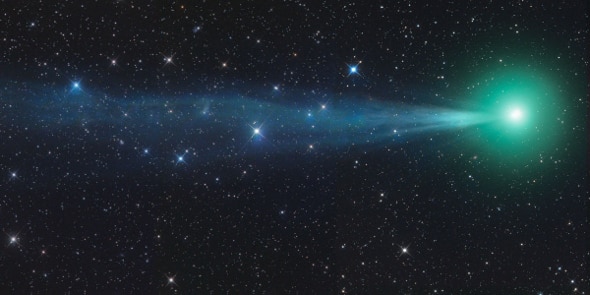Create a free profile to get unlimited access to exclusive videos, sweepstakes, and more!
Bright Comet Lovejoy Rings in the New Year!

2014 hasn’t even ended yet and we already have one of the best comets of 2015 showing off in our skies: C/2014 Q2 (Lovejoy), already visible to the naked eye and predicted to get brighter over the next couple of weeks!
This is the fifth comet discovered by Australian "amateur" astronomer Terry Lovejoy. In 2011, one of “his” comets made a spectacular pass through the sky. This one may not be quite so ostentatious, but its location and brightness make it a winner. On Jan. 7 it will pass about 70 million kilometers (44 million miles) from Earth, and it’s predicted to peak around 4th magnitude; easily visible from dark skies without optical aid.
As a bonus, it’s passing near the constellation of Orion, making it easier to find, and it’ll also glide past Taurus and the Pleiades, providing for what should be some pretty photogenic scenes. It’s moving roughly north, so it gets higher all the time for Northern Hemisphere observers.
I went out on the evening of Dec. 28 to take a look (in between snowstorms here in Colorado) and found it easily using my trusty 10x50 binoculars, not far from Rigel, the blue star marking Orion’s left foot. With my larger 15x70s (Celestron’s SkyMaster binocs, before you ask) I could see the tail, too, despite looking through city lights in that direction, plus having a first quarter Moon illuminating the sky. I’m kicking myself that I didn’t take any pictures, but the temperature was hovering near -15° C, so I’m willing to forgive myself.
If you want to see this comet for yourself—and you do—it rises a couple of hours after sunset. For now, I suggest waiting until about 9-ish or so to look, since it will be high off the horizon then, but your kilometerage may vary. It rises earlier every day, and by early January it’ll be high up by the time it gets dark (though the nearly full Moon will make things tougher; after about Jan. 7 or so the Moon will rise late enough that it won’t be as big a problem). Sky and Telescope has excellent maps with the comet’s path on them. If you have bad weather, or just want to stay indoors, the Virtual Telescope Project will have live online viewings on Jan. 6 and Jan. 11, 2015.
Here's a nifty three-hour time-lapse animation showing the comet's movement, taken by Phil Hart on Dec. 28, 2014:
In the photos here the comet appears green; many do due to the way their constituent molecules glow when reacting to sunlight. That color may not be apparent to the eye when you see it, though. It looked gray to me when I saw it, but long exposures using cameras bring out the green hue.
As for the physical nature of the comet itself, it’s on a pretty long-period orbit, taking about 14,000 years to go around the Sun.* The orbit takes it out to a distance of nearly 90 billion kilometers (for comparison, Neptune orbits at a distance of 4.5 billion kilometers). So Lovejoy got its start way the heck out in the solar system. The orbit is also wildly tilted to the plane of the solar system; it’s tipped by 80° to the paths the planets take. That’s why it’s getting so much better to see for northern observers; it’s heading up and out of the ecliptic (the line on the sky marking the path of the Sun, which is close to the plane of the solar system; we see it edge-on so it looks like a line). This may not be the first time this comet has headed into our neighborhood, but it’s a good bet it’s the last any of us will get to see it.
In other words: Here’s your chance. Take it.
*Correction, Dec. 30, 2014: The comet's orbit is 14,000 years long, not 40,000 as I originally wrote.


























